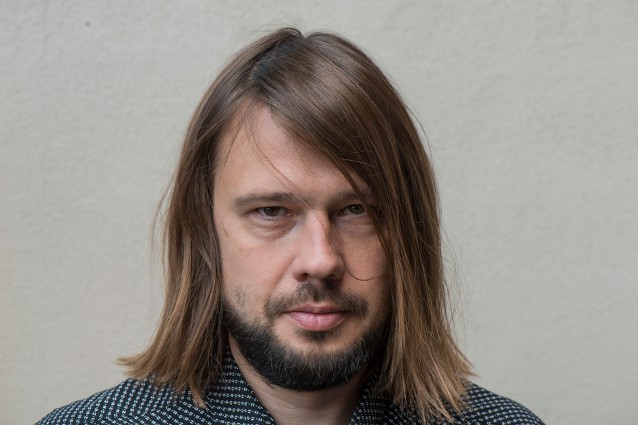Phone
+371 6701 9393
E-mail
info(abols)industra.finance

INDUSTRA operations are based on implementation of ideas and energy of businessmen in life. The Bank was pleased when Latvian Artist Andris Vītoliņš kindly agreed to lend a number of his industrial environments works for visual language of the Bank enabling to present values of the Bank via expression of the Artist.
After graduation from the Art Academy of Latvia (where he returned now to teach painting), over the years A. Vītoliņš has developed his own art vision – bright, unusual colour combinations, expressive brush stroke and composition, industrial objects where enormous energy of machines created by human is restricted. INDUSTRA talks to the Artist to identify origin and essence of his unique approach.
How did you find your special art signature?
My time spent at the Art Academy was intensive in fact– I studied design in the Visual Communication Department and believed that it left effect – my view developed in the different way that one of classic painters. During design studies, I had interest in equipment, technologies, machines and it was somehow contrast to that classic or romantic that people often expect from painting. When thinking about painting, people usually imagine landscape, flowers, ships – harmony that relaxes or encourages self-reflection; however, under the influence of design, I got growing interest into structure and rhythm observed by myself in different machines and industrial environment.
My first work in this style was a coincidence – I found a diapositive with a factory photo that inspired me to find such environment by myself. I started purposefully looking for and documenting interesting industrial places, hiking while waiting for special light, for example, in spring when it was minus ten degrees Celsius, when the light extremely strongly highlights a structure of environment, shadows. That in some aspects overlapped the time of changes when technologies surrounded by us globally changes and effect of such entered our everyday life more intensively.
What do you see when looking at, for example, factory buildings or industrial pipe constructions?
The rhythm is very important for me.
I believe that it is the thing affecting life and work of a person while being in close relation with heartbeat. I often have my own view and I found as a subject that is in nature enabling me to implement my vision and accordingly – their visual rhythm sense relevant to me at that moment.
Do you try to reflect reality in your works or you paint your own view where real environment is basically only a raw material?
My works are taking advantage of reality where I keep something, however something comes from me as addition.
Do you paint plein air or from photographs?
It is usually from photographs; however, I also painted plein air but it is often impossible as industrial objects are usually closed. I had such situations when owners of industrial buildings allowed to take photographs before their completion as later it will be forbidden when the factory will be already working.
Sometimes search for materials and taking of photographs took me to unusual places, for example, Vienna, to large oil processing plant having even its own railway station for workers. Sometimes when visiting such places I feel very uneasy as in such environment a person with photo camera is a stranger – you should get used to that you are observed, security workers pay attention, from an observer you turn into an object of interest. I even have an incident in Netherlands where after a five-minute observation of an object I was arrested by the police.
I still go on hikes, also abroad to look for material that would be interesting for me to be painted.
When you observe selected art objects, do you notice also their content, except a visual value?
I am usually trying to understand what is a specific industrial building, how a specific plant works, mechanism, technology. It is extremely important to appreciate technical idea of engineers, applied techniques. It is a special satisfaction – to understand the way it works or the way how already historical factory or machine worked. Process logic contains robust, uncompromising beauty.
In plants, enormous energy is restricted and purposefully directed – and this energy is a source of emotions created by my painting’s visual impression.
Is absence of humans in your paintings intentional?
Yes, because the presence of a person in a painting creates completely different emotional content. It is already other communication and a person creates other dynamics of relation in his/her environment. However, it should be noted that in my paintings a person is always present – only in the intermediary way because notwithstanding the level of abstractness of industrial machinery, it has always been created by human. It is completely different than painting an empty beach – there is no person in fact and we can imagine a person from our experience.
I paint industrial landscapes, which are, however, created by humans.
What are your plans for the future? What kind of evolution do you predict for your painting?
I have a growing interest in newly-created objects, environment created by myself. I believe that in modern life it is particularly important to create new forms not existing in reality. I suppose that it will be always important to create and synthesise from something existing for art development.